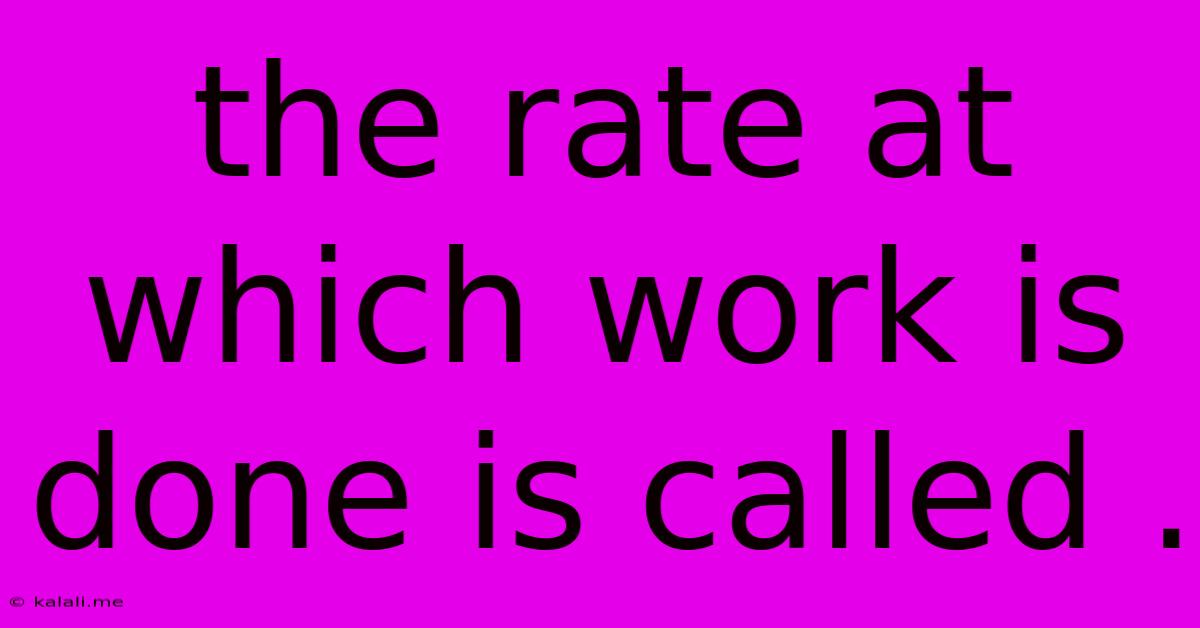The Rate At Which Work Is Done Is Called
Kalali
Jun 12, 2025 · 3 min read

Table of Contents
The Rate at Which Work is Done is Called: Power Explained
The rate at which work is done is called power. Understanding power is crucial in physics and engineering, as it describes how efficiently energy is transferred or transformed. This article will delve into the concept of power, explore its formula, units of measurement, and provide real-world examples to solidify your understanding. It will also touch upon related concepts like work and energy to provide a complete picture.
Power is a fundamental concept that measures the speed of doing work. It's not just about how much work is done, but how quickly it's done. This distinction is vital in various applications, from designing efficient engines to analyzing the performance of athletes.
Understanding Work and Energy
Before diving into power, let's briefly revisit the concepts of work and energy. Work is done when a force causes an object to move a certain distance. The formula for work is:
Work (W) = Force (F) x Distance (d)
Energy is the capacity to do work. When work is done, energy is transferred or transformed. Energy exists in many forms, including kinetic energy (energy of motion), potential energy (stored energy), and thermal energy (heat).
The Power Formula
The formula for power directly relates work and time:
Power (P) = Work (W) / Time (t)
This means power is the amount of work done divided by the time it takes to do that work. Since work is measured in Joules (J) and time in seconds (s), the unit of power is Joules per second (J/s), which is also known as a Watt (W).
Different Units of Power
While Watts are the standard unit, other units are also used depending on the context:
- Horsepower (hp): A historical unit often used for engines and motors. 1 hp is approximately 746 Watts.
- Kilowatts (kW): Used for larger power outputs, such as those found in power plants or industrial machinery. 1 kW = 1000 W.
- Megawatts (MW): Used for extremely large power outputs. 1 MW = 1,000,000 W.
Real-World Examples of Power
Let's look at some examples to illustrate the concept:
- A powerful engine: A high-powered engine can do a large amount of work (like accelerating a car) in a short amount of time, demonstrating high power.
- A less powerful engine: A less powerful engine might do the same amount of work, but it will take a longer time, resulting in lower power.
- Human Power: A weightlifter lifting a heavy weight quickly exhibits greater power than someone lifting the same weight slowly.
Power and Efficiency
Power is closely tied to the efficiency of a system. A more efficient system can perform the same amount of work using less energy, resulting in higher power output for the same energy input. This is a key consideration in designing and optimizing machines and processes.
In conclusion, understanding the concept of power is crucial for comprehending how efficiently work is done. From engineering marvels to everyday activities, the rate at which work is performed is a key factor determining performance and efficiency. By understanding its formula, units, and applications, you can gain a deeper appreciation of this fundamental concept in physics and engineering.
Latest Posts
Latest Posts
-
Half A Percent As A Decimal
Jun 13, 2025
-
Gpa Requirements For University Of San Diego
Jun 13, 2025
-
Which Of The Following Is An Aldehyde
Jun 13, 2025
-
Laughter Is The Best Medicine Speech
Jun 13, 2025
-
List All The Factors Of 32
Jun 13, 2025
Related Post
Thank you for visiting our website which covers about The Rate At Which Work Is Done Is Called . We hope the information provided has been useful to you. Feel free to contact us if you have any questions or need further assistance. See you next time and don't miss to bookmark.